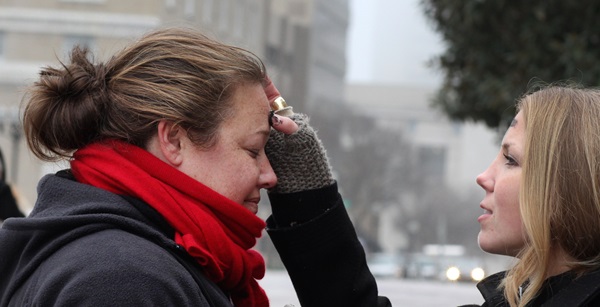One Wednesday a year, sometime in February or March, you notice people at work, school, or elsewhere with a smudge on her forehead. Then you remember it is Ash Wednesday and they must have received the imposition of ashes.
This practice we use to mark the first day of Lent may seem odd. People go to church mid-week to have a cleric place dirt on their foreheads.
In the early days of the church, it was even more dramatic. Pastors did not dip their thumbs into the ashes to draw the shape of a cross on your forehead. Instead, they poured or sprinkled ashes over your head.
Under other circumstances, most would run from the filth of ashes. Yet we participate in this practice that is growing in popularity. In fact, the receiving of ashes seems to connect with all sorts of people.

The Rev. Kim Kinsey offers ashes to a youth on the sidewalk outside of Christ United Methodist Church in Albuquerque, NM. Photo courtesy of the Rev. Kim Kinsey.
Why ashes?
In "A Service for Worship for Ash Wednesday" in the United Methodist Book of Worship, two suggestions of what worship leaders may say as they make the sign of the cross on another's forehead are offered: "Remember that you are dust, and to dust you shall return," and "Repent, and believe the gospel." Each points to an aspect of what the ashes represent.
Remember that you are dust…
Ashes were an ancient symbol of our humanity. In Genesis, we read that God formed human beings out of the dust of the earth (Genesis 2:7). The Hebrew word translated dust, is occasionally translated ashes elsewhere.
When Abraham felt the need to acknowledge the difference between him, a human being, and the infinite God, he referred to himself as dust and ashes. "Let me take it upon myself to speak to the Lord," he said, "I who am but dust and ashes" (Genesis 18:27).
…and to dust you shall return
Our humanity also calls to mind our mortality.
After expulsion from the Garden of Eden, the first humans are told by God, "you are dust, and to dust you shall return" (Genesis 3:19 NRSV). A sobering thought for each of us.
Ancient people wore ashes as a sign of mourning. For example, Mordecai puts on sackcloth and ashes to grieve the many deaths he sees coming from an order King Ahasuerus gives to kill all Jewish people (Esther 4:1-3). The prophet Jeremiah later calls the people of God to "roll in ashes" as a way of mourning the coming devastation from an opposing army (Jeremiah 6:26).
Receiving the imposition of ashes is a powerful way to confront our humanity and mortality. They remind us that we are not God, but God's good creation. In them we recognize that our bodies will not last forever, and come face-to-face with the reality of our eventual death.
Repent…
Ashes also signify our sorrow for the mistakes we have made. People in ancient times wore sackcloth and ashes as a way of expressing their repentance of their sins.
When Jonah reluctantly preached to the people of Nineveh after the giant fish spit him up on the beach, the King and his people put on sackcloth and sat in ashes. God saw this act of repentance and spared the people (Jonah 3:1-10).
In the New Testament, Jesus warms the cities of Chorazin and Bethsaida saying, "if the miracles done among you had been done in Tyre and Sidon, they would have changed their hearts and lives and put on funeral clothes and ashes a long time ago." (Matthew 11:21 CEB).

The dried palms from the previous Palm Sunday are burned to make the ashes for Ash Wednesday. Photo by Kathryn Price, United Methodist Communications.
On Ash Wednesday, we confront our sin. We recognize our inability to live up to all God has created us to be, and our need to be forgiven. No matter how far we have come in our spiritual journeys, each of us has sinned and fallen short of the glory of God (Romans 3:23).
The palms waved the previous Palm Sunday to welcome Jesus as our King, are burned to form the ashes. In a sense, they serve as a reminder of how far we fall short of living up to the glory of Christ.
…and believe the gospel
While this all may sound fatalistic, it is not the end of the story. Lent leads to Easter, the day we celebrate that though our bodies are temporary and our lives are flawed, a day of resurrection will come when we will live in the presence of God forever.
One Wednesday every year we worship to remember who we are, and hopeful of who we can be.
Looking for an Ash Wednesday service? Find-A-Church can help you locate the United Methodist Church nearest you.
Joe Iovino works for UMC.org at United Methodist Communications. He may be reached at [email protected] or 615-312-3733.
This story was originally posted February 9, 2015. Updated January 2021.





